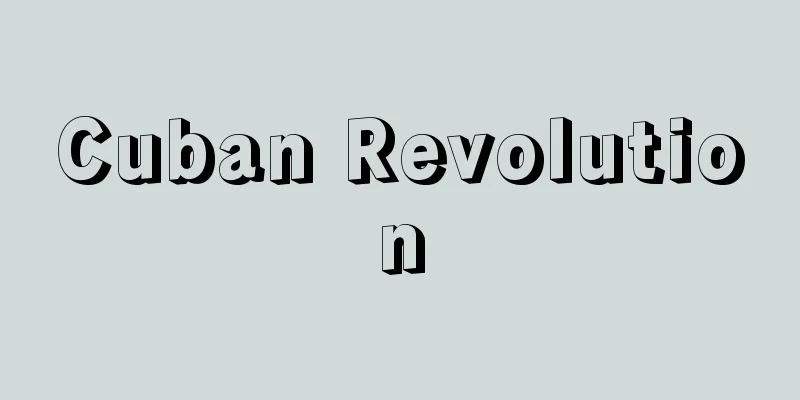Cuban Revolution

|
A revolution that took place on the small Caribbean island of Cuba. After overthrowing a dictatorship through armed struggle through guerilla warfare, it developed into the first socialist revolution in Latin America. This unique revolution, which achieved socialism without the leadership of an existing communist party, had a major impact on subsequent Latin American revolutionary movements due to its unique revolutionary method of seizing power through guerilla warfare and the theory that only a socialist revolution can truly free Latin America from external dependency and underdevelopment. The social and economic background of the revolution was the situation in which Cuba had been under the colonial rule of the United States since it gained independence as a protectorate of the United States in the early 20th century. At the time of independence, the US government forced the insertion of a clause (the Platt Amendment) in the Cuban constitution that stipulated that it could intervene in domestic and foreign affairs at any time if necessary, and in fact intervened militarily in the country several times until the clause was repealed in 1934. Meanwhile, US investment in Cuba, mainly in the sugar industry, which had been conducted since the end of the 19th century, continued to increase even after independence, and Cuba's economy became a sugar monoculture that was significantly dependent on the United States. Before the revolution, most of the land was concentrated in the hands of large American and Cuban landowners, and the number of landless tenant farmers and agricultural laborers accounted for about 80% of the peasant population. The period outside the sugarcane harvest season was called the "death season," and many peasants and laborers lost their jobs and suffered from poverty and hunger. The influx of American products prevented industrialization to absorb them. The 1940 Constitution provided for land reform and industrialization, but before these could be implemented by successive governments, a military coup in March 1952 brought Fulgencio Batista to power, ushering in a new phase of colonial rule. The first stage of the revolution began on July 26, 1953, when armed young men led by Fidel Castro rose up in rebellion to overthrow Batista. The "Moncada Barracks Attack" failed, and Castro and his men were captured and convicted in a trial. They were eventually released on an amnesty and traveled to Mexico, where they formed a revolutionary organization called the "26th of July Movement." At the end of 1956, they invaded Cuba on the "Granma" and began a new revolutionary war of guerilla warfare in the Sierra Maestra mountains in Oriente Province. They enlisted peasants in the struggle and organized a united front against Batista made up of a wide range of people, and on January 1, 1959, they finally ousted Batista from power, having been abandoned by the US government and left alone. The first government after the revolution was a moderate government including the middle class, but real power was held by Castro, who was the commander-in-chief of the revolutionary army.As soon as he enacted the First Land Reform Law in May 1959 and began structural reform of Cuban society, the moderates began to drop out of the revolution and relations with the US government deteriorated.After the complete nationalization of American assets in October 1960 and the severance of diplomatic relations with the United States in January 1961, Cuba finally declared a socialist revolution in April 1961. [Yuzo Kamo December 12, 2016] "Documents of Modern History 11: The Cuban Revolution" edited by Kamo Yuzo (1973, Heibonsha) " "The Castro Way: From Guerrilla to Power" by K.S. Carroll, translated by Yanagida Yasuo (1972, Yomiuri Shimbun) " "Fidel Castro: The Creative Force of Rebellion and Revolution" by Herbert Matthews, translated by Kamo Yuzo (1971, Kinokuniya Shoten)" [References] | | | |Source: Shogakukan Encyclopedia Nipponica About Encyclopedia Nipponica Information | Legend |
|
カリブ海の小島キューバで起こった革命。ゲリラ戦による武装闘争で独裁政権を打倒したのち、ラテンアメリカで最初の社会主義革命へと発展した。既存の共産党の指導によらずに社会主義革命を達成したこのユニークな革命は、ゲリラ戦で権力を奪取するという独特な革命の方法や、ラテンアメリカでは社会主義革命によってのみ対外的従属や低開発の状態から真に脱却できるという理論を提起したことにより、その後のラテンアメリカの革命運動に大きな影響を及ぼした。 革命の社会的、経済的背景となったのは、この国が20世紀初めにアメリカの「保護国」として独立して以来、実質的にアメリカの植民地支配下に置かれてきた状況である。アメリカ政府は独立に際してキューバの憲法に、必要とあればいつでも内外政に干渉できることを規定した条項(プラット修正)の挿入を強制し、事実その条項が1934年に撤回されるまで数次にわたってこの国に軍事干渉を行った。一方、19世紀末以来、砂糖産業を中心に行われたアメリカの対キューバ投資は独立後も増大し続けたため、キューバの経済は著しく対米従属的な砂糖モノカルチュア経済となった。革命前、大部分の土地はアメリカ人やキューバ人の大地主の手に集中し、土地を所有しない小作人や農業労働者の数は農民の約80%を占めた。サトウキビの収穫期以外の時期は「死の季節」とよばれ、多くの農民や労働者が失業し、貧困や飢餓で苦しんだ。彼らを吸収するための工業化もアメリカ製品の流入によって遮られた。1940年の憲法は土地改革や工業化を定めていたが、歴代政府のもとでそれらが実施されぬうちに、1952年3月、軍事クーデターでフルヘンシオ・バチスタが政権につき、植民地的支配の新たな局面が現れた。 革命の第一段階は、1953年7月26日、フィデル・カストロが率いる武装した青年たちがバチスタ打倒のための反乱に立ち上がったことにより始まった。この「モンカダ兵営襲撃」は失敗し、カストロらは捕らえられ裁判で有罪判決を受けた。やがて恩赦で釈放された彼らはメキシコに渡り、そこで革命組織「7月26日運動」を結成した。1956年末「グランマ」号に乗ってキューバに侵入した彼らは、オリエンテ州のシエラ・マエストラ山脈を舞台にゲリラ戦による新たな革命戦争を開始した。彼らは農民たちを闘争に参加させるとともに、広範な階層よりなる反バチスタ統一戦線を組織して闘いを進め、1959年1月1日、アメリカ政府からも見離され孤立無援となったバチスタをついに政権の座から追放した。革命後最初の政権は、中産階級を含む穏健な政府であったが、実権は革命軍の総司令官であったカストロが握っており、1959年5月に第一次農地改革法を制定してキューバ社会の構造改革に着手するや、穏健派が革命から脱落し始めるとともに、アメリカ政府との関係も悪化し、1960年10月のアメリカ人資産の全面国有化、1961年1月のアメリカとの国交断絶を経て、ついに1961年4月に社会主義革命を宣言するに至った。 [加茂雄三 2016年12月12日] 『加茂雄三編『ドキュメント現代史11 キューバ革命』(1973・平凡社)』▽『K・S・カロル著、弥永康夫訳『カストロの道――ゲリラから権力へ』(1972・読売新聞社)』▽『ハーバート・マシューズ著、加茂雄三訳『フィデル・カストロ――反乱と革命の創造力』(1971・紀伊國屋書店)』 [参照項目] | | | |出典 小学館 日本大百科全書(ニッポニカ)日本大百科全書(ニッポニカ)について 情報 | 凡例 |
>>: Cuba - Cuba (English spelling)
Recommend
Guillmot (sea gull)
A large Charadriiformes bird with a relatively lon...
Grass fortune telling - Grass fortune telling
...In those days, people would first consult the ...
Leder Karpfen (English spelling)
…These species were developed and improved long a...
İbrahim Paşa
1493‐1536 Grand vizier (sadorazam) of the Ottoman ...
variable geometry wing
… A swept-back wing with a large sweep angle is a...
Attica - Attika (English spelling)
Attica is a prefecture located at the tip of the ...
Waterman, LE - Waterman
…The English word fountain pen was used in the 18...
Chinchilla rat
A general term for mammals of the Abrocomidae fami...
Course in Analysis - Course in Analysis
...Thus, the above theorem, which at first glance...
Hockett, C.
...The heyday of American structural linguistics,...
Forced convection - forced convection
Convection caused by external factors such as heat...
Kinkel, Klaus
Born December 1936. Mettinger. German politician. ...
floating-leaved plant
…Aquatic plants are also called mizukusa. They ar...
Reduction dyeing method
...(2) Mordant dyeing method: When dye molecules ...
Humidity - Shitsudo (English spelling) humidity
A quantity that indicates the amount of water vap...









